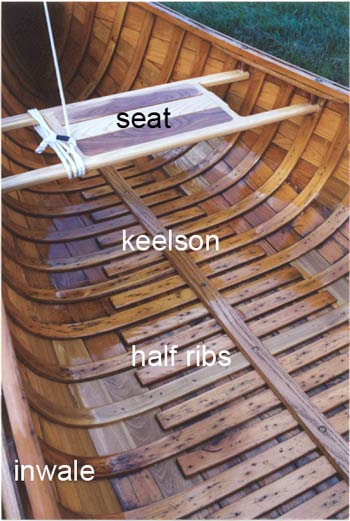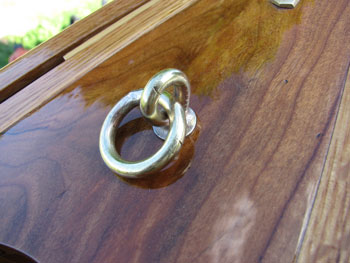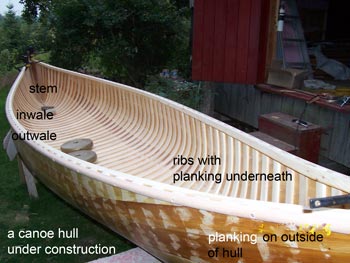The Following List Describes the Major Parts of a Cedar Canvas Canoe.
Hull:
This term refers to the body of the canoe and defines its overall shape. The hull is composed of ribs and planks covered, on the outside, with canvas.
Ribs:
These are the members, made of white cedar, that run from side to side across the bottom of the canoe. The planking is attached to the ribs and together they form the hull of the canoe.
Planks:
These are the thin pieces of white or red cedar, usually 3 or 4 inches wide, that run lengthwise on the canoe on the outside of the ribs.
Half ribs:
If desired, the floor of the canoe can be strengthened by the placement of 'half ribs' between the full ribs. These are only half as wide as the full ribs and are only long enough to span the floor area of the canoe.
Tacks:
The planking is fastened to the ribs with brass tacks. The clinched ends of the tacks are visible on the inner surface of the ribs. A 16 foot canoe requires about 2,000 tacks in its construction.
Stems:
These are the curved pieces that form the shape of the ends of the canoe. They run from the floor of the canoe to the underside of the point of the decks. The ends of the planks are attached to the stems and they in turn are covered by canvas and then brass stem bands. To be precise, only the front piece of a vessel is called the stem. However, since both ends of a canoe are the same shape, they are both referred to as stems.
Gunwales (pronounced 'gunnels'):
These are the wooden pieces that run full length along the top of each side of the canoe. There are 'inner' and 'outer' gunwales which are screwed together with the ends of the ribs in between.
Decks:
These are the triangular pieces of wood that hold the inwales together at either end of the canoe.
Canvas:
This is the cotton fabric that covers the outside of the canoe. It is filled and painted to make the canoe waterproof. (Some canoes are covered with Dacron, a synthetic polyester fabric, instead of canvas.)
Filler:
This is the material that is rubbed into the canvas or Dacron to fill the weave and create a smooth, hard base for the exterior paint.
Thwart:
This is the wooden member that spans the open side of the canoe, from gunwale to gunwale, usually at the centre of the canoe. All canoes have at least one thwart and many have two, the second located between the centre thwart and the stern seat. On occasion, a canoe will have a third thwart just behind the bow seat. The thwarts maintain the shape of the canoe and provide structural support for the gunwales.
Paddling Thwart:
To facilitate paddling from a kneeling position, 'paddling thwarts' may be installed in place of seats or, for solo paddling, near the centre of the canoe. These thwarts are shaped and installed so that the paddler can lean back against them for comfort and support.

Deck Thwarts or Handles:
These are small thwarts located just behind the decks of the canoe. They are used by two people to carry the canoe in an upright position, and are the preferred place to tie ropes when car-topping the canoe. Not all canoes have deck thwarts.
Carrying Yoke:
When desired, the centre thwart can be replaced by a carrying yoke which is shaped to fit onto the shoulders of a person carrying the canoe overhead. It provides greater comfort because of its shape.
Keel:
The keel is the wooden strip that runs lengthwise down the middle of the hull on the outside. A 'shoe keel' is a flat, wide keel, generally about 2" wide and about 3/8" thick. A 'standard' keel is generally deeper than it is wide and, typically, could measure an inch or so deep and 7/8" wide. Not all canoes have a keel.
Keelson:
This is a keel-like strip that runs the full length of the canoe on the inside. Most canvas covered canoes do not have a keelson but occasionally they are encountered.
Stem Bands:
These are metal (usually brass ) strips mounted on the outside of the ends of the canoe. They protect the underlying seam in the canvas and give the canoe a smart finished appearance.
Outside Stems:
Some canoes, especially older ones, have an additional stem piece on the outside of the canvas.
Seats:
Most canoes have a bow seat and a stern seat that paddlers sit on while paddling. Smaller canoes, which are intended to be paddled solo, may have only one seat located near the centre. Some canoes have no seats and must be paddled from a kneeling position or sitting position on the bottom of the hull.
Seat Bolts:
These are long brass or bronze bolts that are used to attach the seats to the inwales.
Deck Rings:
These are brass rings attached to the decks of a canoe for the purpose of attaching a rope. Not all canoes have deck rings.
you are at the bottom of the 'Canoe Parts' page

